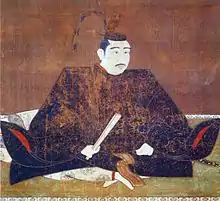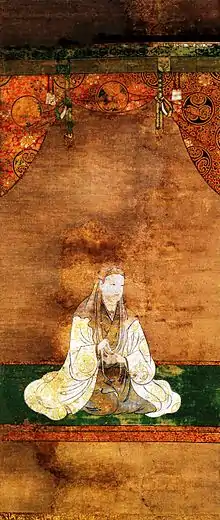Ikeda Terumasa
Ikeda Terumasa (池田 輝政, January 31, 1565 – March 16, 1613) was a Japanese daimyō of the early Edo period. His court title was Musashi no Kami. Terumasa was also known by the nickname saigoku no shōgun, or, "The Shōgun of Western Japan". Terumasa fought in many of the battles of the late Azuchi–Momoyama period, and due to his service at the Battle of Sekigahara, received a fief at Himeji. His childhood name was Araokojimaru (荒尾古新丸). He was the son of Ikeda Tsuneoki and brother of Ikeda Sen.
Ikeda Terumasa | |
|---|---|
 Ikeda Terumasa | |
| Daimyō of Himeji | |
| In office 1600–1613 | |
| Preceded by | none |
| Succeeded by | Ikeda Toshitaka |
| Personal details | |
| Born | January 31, 1565 |
| Died | March 16, 1613 (aged 48) |
| Nationality | Japanese |
| Spouse(s) | Toku Hime |
Background

The 2nd son and heir of Ikeda Nobuteru, Terumasa held Ikejiri Castle (Mino Province) and joined his father in fighting for Hideyoshi in the Komaki Campaign (1584). He led troops at Nagakute (1584), the battle in which his father was killed. In 1590, following the transfer of Tokugawa Ieyasu to the Kanto, Terumasa was established at Yoshida in Mikawa, a 152,000-koku fief. In 1594 Terumasa married one of Tokugawa's daughters, and after Hideyoshi's death in 1598, the Ikeda drifted into Ieyasu's camp.
Battle of Sekigahara
When the Sekigahara Campaign began in the fall of 1600, Terumasa immediately sided with his father-in-law, Tokugawa.[1] On 28 September he competed with Fukushima Masanori to be the first to attack Gifu, held by Oda Hidenobu. At the Battle of Sekigahara, Ikeda commanded 4,560 troops[1] in the rear guard and saw some desultory fighting with Chosokabe Morichika's contingent as the battle wound down.
Following the Tokugawa victory, Terumasa was given a 520,000-koku fief and the province of Harima.[2] He expanded the Himeji Castle, which he completed in 1609.[3] In 1603 Bizen was added to Terumasa's territory, and this he assigned to his eldest son, Toshitaka (1584–1616). By the time of Terumasa's death in 1613, the Ikeda had grown to rule over Harima, Bizen, Inaba, and Awaji, with a combined income of around 1,000,000-koku. Following the death of Toshitaka, the Tokugawa Bakufu took steps to reduce the alarming power of the Ikeda and eventually reduced the family to Tottori (Inaba) and Okayama (Bizen).
Ōkanehira sword
Ōkanehira or Great Kanehira, refers to the extraordinary size of the blade. Work of Kanehira from Bizen Province, owned by Ikeda Terumasa and passed down in the Ikeda clan.
Family

- Father: Ikeda Tsuneoki
- Mother: Zen'ōin
- Sister: Ikeda Sen
- Wives:
- Itohime, daughter of Nakagawa Kiyohide
- Tokuhime (Tokugawa)
- Concubines:
- Manganin
- daughter of ando clan
- Children:
- Ikeda Toshitaka (1584–1616) by Itohime
- Ikeda Tadatsugu (1599–1615) by Tokuhime (Tokugawa)
- Ikeda Teruzumi (1604–1662) by Tokuhime (Tokugawa)
- Ikeda Masatsuna (1605–1631) by Tokuhime (Tokugawa)
- Ikeda Tadakatsu (1602–1632) by Tokuhime (Tokugawa)
- Ikeda Teruoki (1611–1647) by Tokuhime (Tokugawa)
- Chacha-hime married Kyogoku Takahiro by Tokuhime (Tokugawa)
- Furihime (1607–1659) married Date Tadamune by Tokuhime (Tokugawa)
- Ikeda Masatora (1590–1635) by Manganin
- Ikeda Toshimasa (1594–1639) by daughter of Ando clan
- Ikeda Terutaka
References
- Wilkinson, Philip (2012-08-20). Great Buildings. London: Dorling Kindersley Limited. p. 128. ISBN 9780756698294.
- Poitras, Gilles (2005). The Anime Companion 2: More What's Japanese in Japanese Animation?. Berkeley, CA: Stone Bridge Press. p. 30. ISBN 1880656965.
- Deal, William E. (2007). Handbook to Life in Medieval and Early Modern Japan. Oxford: Oxford University Press. p. 316. ISBN 9780195331264.
- (in Japanese) Japanese Wikipedia article on Terumasa (23 October 2007)
Further reading